Inflation Deflation Switch Turns Entire Investment World Upside Down for 2009
Economics / Investing 2009 Dec 23, 2008 - 12:52 PM GMT Martin Weiss writes: The Fed, the Treasury and all major governments on the planet are throwing the kitchen sink at this debt crisis.
Martin Weiss writes: The Fed, the Treasury and all major governments on the planet are throwing the kitchen sink at this debt crisis.
But their efforts are being overwhelmed by a monumental sea change — the shift from rising prices to falling prices, from booming asset values to crashing asset values, from wealth creation to wealth destruction , from inflation to deflation.
For my entire lifetime, and probably yours as well, we have been living with inflation — sometimes tame, sometimes rampant — but consistently eroding the purchasing power of our dollar.
Inflation pervaded every money decision we made or thought about making, every retirement plan or business model. Inflation was factored into our leases, our employment contracts, our budgets, our investment programs.
Now, all of that is changing; and it's doing so dramatically! Suddenly, the polar opposite of inflation is taking hold in America: Deflation!
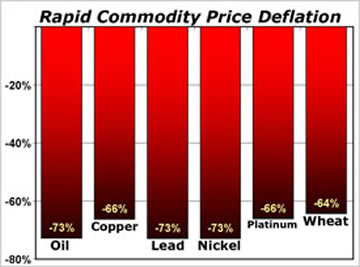 |
Suddenly, prices are plummeting — not just for real estate, but also for automobiles, appliances, clothing and gasoline.
From peaks reached just a few months ago to the latest bottoms, the price of oil has plunged 73% … copper has fallen 66% … lead and nickel are down 73% … platinum is down 66% … and wheat is off 64%.
Even the government's slow-to-change, lagging index of inflation — the CPI — has caved in to deflation, falling by the most since the government first introduced the index in 1946.
These are not numbers that denote less inflation. They are hard evidence of outright deflation!
This is crucial for you: If you continue investing as you did in inflationary times, you risk losing almost everything. However, if you acknowledge this historic shift and make the right moves now, you'll have the opportunity to build substantial wealth.
This inflation-deflation switch is turning the entire world of investments upside down and inside out.
It means you must consider the grave new dangers deflation brings your portfolio and , at the same time, the unique new opportunities deflation gives you to grow your wealth. And last week, I talked at length with Weiss Research's currency expert, Jack Crooks, to cover both:
Deflation Survival Briefing
with Martin D. Weiss and Jack Crooks
(Edited Transcript)
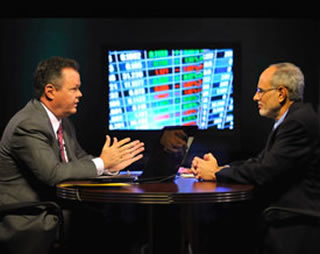 |
Martin Weiss: Jack, in this discussion, I will focus on the dangers and protective strategies; you can focus on the profit opportunities.
Jack Crooks: That makes sense, but I think it's pretty obvious what the dangers are.
Martin: Specifically, you're referring to …
Jack: Losing money. Losing a lot of money. Deflation means most asset prices go down. When asset prices go down, anyone who owns those assets loses money. It's that simple.
Martin: What most people don't seem to grasp is how much money — the sheer magnitude of the losses. But the Fed just released the numbers, and I want to show them to you. I want you to see for yourself the amazing drama that literally bursts from these pages.
On the Web, just go to Flow of Funds , pdf page 113. From this table, I've pulled out the main numbers to walk you through this step by step, because it's probably the most important set of facts you've seen — or will see — for a long time:
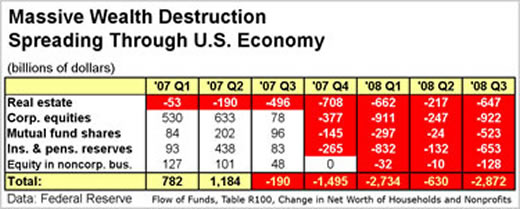 |
The Fed tracks five key sectors that go into household wealth: real estate, corporate equities, mutual fund shares, life insurance and pension fund reserves, plus equity in noncorporate businesses. Now let me show you how the wealth destruction is spreading throughout the U.S. economy.
First quarter 2007: Every single wealth sector is still growing, except one — real estate. This $53 billion loss in real estate is a time and place that will go down in history as the great turning point of our era.
Second quarter 2007: Another $190 billion in real estate wealth destroyed.
Third quarter 2007: Households suffer a whopping $496 billion in losses — nearly 10 times as much as in the first quarter.
Fourth quarter 2007: The wealth destruction spreads to nearly all other sectors. Households lose $708 billion in real estate, the most in history. Plus, they lose $377 billion in stocks, $145 billion in mutual funds, $265 billion in their life insurance and pension reserves.
First quarter 2008: The carnage deepens. Households lose $911 billion in stocks, $297 billion in mutual funds and $832 billion in insurance and pension fund reserves. Plus, the losses spread to the last major sector, equity in noncorporate businesses.
Second quarter 2008: The Bush economic stimulus package kicks in, and it slows down the pace a bit. But the hemorrhaging continues. Not one single sector recovers.
Third quarter 2008: Earth-shattering losses across the board, with households losing …
- ANOTHER $647 billion in real estate
- $922 billion in corporate equities
- $523 billion in mutual funds
- $653 billion in insurance and pension fund reserves
- $128 billion in noncorporate businesses
Grand total: Nearly $2.9 trillion in losses — the worst in recorded history.
Grand total lost over the past year: $7.7 trillion.
Jack: And this is not just a bunch of numbers. It's a hard-nosed reality that almost everyone is up against.
Martin: Absolutely! At the peak of the housing boom, one of our associates had his home appraised at $1.4 million. Three weeks ago, he had it appraised again and it was down around $700,000. That's a 50% decline. And it's not just the high end of the market. In May 2005, another home in our area sold for $175,000; now it's listed at Realtor.com for only $64,000.
Jack: People think that since home values have already fallen so far, they must be near a bottom.
Martin: I don't agree with that view. Most of the price declines we've seen so far merely represent a recognition that the peak prices of the mid-2000s were a fantasy built upon “Frankenstein Financing” — wildly speculative credit terms such as option ARMs and liar loans. The hard-core declines in housing, driven by basic things like recession and unemployment, are just now getting under way.
Jack: How much further do you see home prices falling?
Martin: My personal opinion is that that over half of the declines are still ahead. That applies not only to housing, but also to commercial properties; not only to real estate, but also to stocks and other assets. Consumer prices just began to fall in October. Outright contractions in the economy are just now getting under way. Deflation is still in its early stages. The wealth destruction has a long way to go.
Jack: You call this wealth destruction and I don't deny the validity of that term. But another way to describe it is rampant deflation . Deflation in the value of real estate and other investments, deflation in energy, deflation at the car dealer and deflation at every mall. In each and every sector that you've described, the U.S. dollar buys more.
Martin: That's the positive side of the story. But whatever you call it, these numbers don't lie. You can see with your own eyes that it's massive and that it's spreading throughout the entire economy.
Jack: Martin, all this raises some urgent questions in my mind and probably in the minds of our readers as well. First, can the government offset this massive destruction of wealth with more bailouts, more Fed actions and gigantic economic stimulus packages?
Martin: They can buy some time or they can slow down the process temporarily, as they did in the second quarter of 2008, for example. But still, my answer is a flat NO! Not even Washington can print enough money fast enough to halt this deflationary spiral; it's just too huge. And all the printing press money in the world won't do much if it's not lent or spent.
Bottom line: No matter which companies Washington bails out, this is a house of cards. It's coming down. And you must get out if its way.
Jack: Still, a lot of people have big expectations for President-elect Obama's stimulus package starting next year.
Martin: The highest estimates for the Obama stimulus package are $1 trillion. But even if it's that big, it's still small in contrast to the wealth destruction we're already seeing. And it's going to take a couple of years before all of that money reaches Americans. By that time, trillions more in wealth could be lost.
Jack: Every economist I read likes to leave some wiggle room for future butt-covering, just in case they turn out to be wrong. But you're not pulling any punches, are you? Why is that?
Martin: It's not needed in this situation — because of the sheer enormity and speed of the wealth destruction: $7.7 trillion just through over the past year. In contrast, the Trouble Asset Relief Program (TARP) is $700 billion. So these losses are already 11 times more than the entire bailout program.
Let's compare how much is being lost vs. what the government is doing to offset it. Here's the progression we just saw:
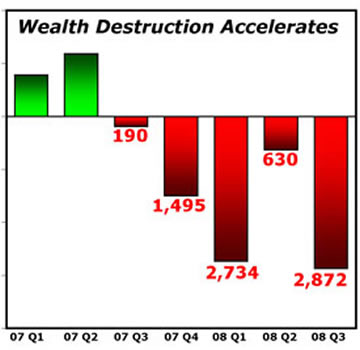 |
- $1.5 trillion lost in the fourth quarter of 2007
- $2.7 trillion lost in the first quarter of 2008
- $630 billion lost in the second quarter of 2008
- $2.9 trillion in the third quarter
Now, let me demonstrate why the government's efforts are unable to offset this wealth destruction. Congress has authorized $700 billion for TARP. But the Treasury Department reports that in the fourth quarter, only $330 billion has been committed so far.
Jack: Committed or actually disbursed?
Martin: Committed.
Jack: The ol' check-in-the-mail routine, eh?
Martin: Yes. But let's assume the $330 billion is already at the banks. And let's say that in the first quarter of 2009, they are able to disburse all of the rest. That's still minuscule in comparison to the wealth destruction.
Jack: Meanwhile, the wealth destruction continues.
Martin: Right. We don't know how much. But let's assume the wealth destruction does not decelerate or accelerate. Let's just assume it continues at the same pace.
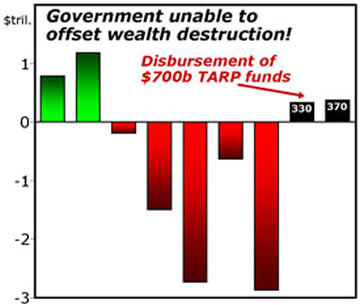 |
Here's what it would look like. Moreover, most of the money being funneled to the banks is not reaching consumers and businesses. Instead, it's sitting idle at the banks, to rebuild their capital, to try to offset all the losses they've sustained.
Jack: How much of the TARP money are the banks actually lending out?
Martin: We don't know.
Jack: Isn't this why Congress is so ticked off, trying to find a way to force the banks to lend out the TARP money?
Martin: Yes. But it's a tough sell. The banks are going broke. They're being asked to lend it to borrowers, who they fear will also go broke. So the resistance is great. But even if you assume that Congress can force the Treasury Department to, in turn, force the banks to loan out some fraction of the TARP money, it would still be only a fraction of the total TARP funds.
Jack: A drop in the bucket.
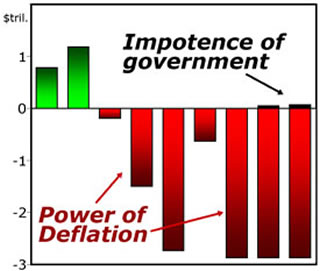 |
Martin: Absolutely! The huge red areas in this chart represent the tremendous power of deflation. The small black areas represent the impotence of government to offset the deflation.
The power of deflation is hundreds of times larger than the government's ability to counteract it. This is why the U.S. government was not able to prevent deflation in the 1930s. And it's also why the Japanese government was unable to prevent its deflation in the 1990s.
Jack: Still, most people think the government can just print more money at will. They're now talking about a total bill of $8.5 trillion. Your numbers don't seem to account for that.
Martin: Because those bigger numbers are almost entirely guarantees and swaps — not net new money added to the economy. Plus, please bear in mind one more thing: The wealth destruction we've been discussing today does not include the losses by financial institutions, corporations and governments.
Jack: Good point. But let me go to the second major question I get from readers: What's causing this and when will it end?
Martin: What's perpetuating the deflation is excess debts. Look. Debts were usually bearable. As long as people had the income to make their payments — or as long as they could borrow from Peter to pay Paul — they could keep piling up more debt, and life went on. Deflation alone is also not so bad. It makes homes more affordable, college education more accessible, and basic necessities of life cheaper.
Jack: But when you put debts and deflation together …
Martin: That's when things fall apart! That's when you get not only wealth destruction but DEBT destruction.
Jack: And we have evidence of that as well, I presume.
Martin: Yes, undeniable, smoking-gun evidence. For decades, we've almost always seen more debt piled up quarter after quarter, year after year. But then, beginning in the third quarter of 2007, all that changed. For the first time, we saw massive debt liquidation — debt destruction.
It started in the commercial paper market, where corporations issue short-term corporate IOUs to borrow in massive amounts: In the third quarter of 2007, instead of growing as it almost always has, commercial paper was being liquidated at a rapid pace. That was the canary in the coal mine.
Jack: And now?
Martin: Now the debt liquidation has spread: In addition to the liquidation of commercial paper, we're seeing massive debt liquidation in mortgages and corporate bonds.
Jack: How big?
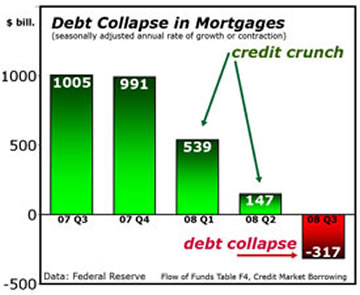 |
Martin:
The biggest ever in recorded history. Look at mortgages! The Fed reports how much in new mortgages are created each quarter at an annual rate. Ever since you and I were born, all we've even seen is net new growth in mortgages. That's how it was when we were growing up, that's how it was in recent years, and that's what we saw in the third quarter of 2007. See?
Jack: $1,005 billion.
Martin: Yes. Net net, after all mortgage paydowns, new mortgages were added at the rate of $1,005 billion per year. Almost the same in the fourth quarter of 2007.
But then look: First quarter 2008 — $539 billion. Second quarter 2008 — new mortgages begin to vanish from the market. Yet, up until this point, we're just talking about a credit crunch.
Jack: In other words, less new credit.
Martin: Yes, and that's already a powerful deflationary force: Most people can't get mortgages. So they can't buy. Since there are few buyers, prices fall. That's when people think: “This is terrible. It couldn't possibly get any worse.”
Jack: But it does, doesn't it?
Martin: Dramatically worse: In third quarter of 2008, the volume of mortgages going bad is so big and the volume of new mortgages being created is so small, we have a net decline in mortgages outstanding. For the first time in recorded history, we have a net destruction of debts in this sector. This is far worse than a credit crunch. It is a DEBT COLLAPSE, an unprecedented, unstoppable deflationary force.
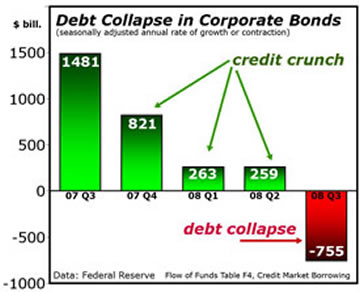 |
The same kind of debt collapse also hits corporate bonds. Third quarter of 2007 — no problem. New bonds are issued at the annual rate of nearly $1,481 billion per year.
Fourth quarter of 2007 — big decline, to $821 billion.
Jack: Credit crunch begins to hit.
Martin: Exactly. First and second quarters of 2008 — credit crunch hits even harder. Third quarter of 2008 — debt collapse strikes! It's the biggest net reduction of corporate bonds in recorded history, running at the annual rate of $755 billion (red bar in chart). Again, one of the most powerful deflationary forces of all time!
Jack: So what's the next stage?
Martin: A chain reaction of corporate bankruptcies.
Jack: But it looks like they're going to save companies like General Motors and Chrysler.
Martin: Even if they do, they cannot save hundreds of thousands of smaller and medium-sized companies that are going bankrupt all over the country … tens of thousands of municipalities and states running out of money … tens of millions of Americans who have gotten smacked with the trillions in losses I've just showed you in the household sector.
This wealth destruction and debt liquidation is classic; and despite all the government intervention, it is fundamentally very similar to the collapse we saw in 1929 and the early 1930s.
Jack: But many people believe the 1930s Depression was caused by the failure of the federal government to fight the decline. This time, they say, the government is doing precisely the opposite.
Martin: In reality, America's First Great Depression wasn't caused by what the government failed to do to stop it. Rather, it was largely caused by all the wild things the government did do to create the superboom in the Roaring '20s that preceded it. They dished out money to banks like candy. They let banks loan money to brokers without restraint. And they encouraged brokers to hand it off to stock market speculators with 10% margin.
But if you want to see what happens when a government intervenes aggressively after a bust, just look at Japan since 1990. Japan lowered interest rates to zero, just like the Fed is doing today. Japan bailed out banks, brokerage firms and insurance companies, much like the Fed is doing here. Japan embarked on massive public works projects, much like President-elect Obama is proposing now.
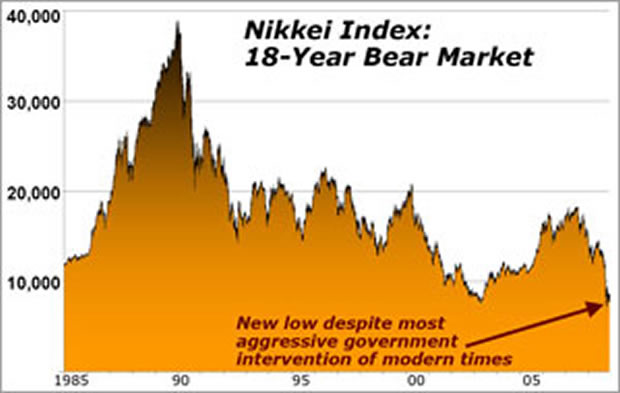 |
But it did not end the deflation. And it did not prevent their stock market from making brand-new lows this year.
All it did was prolong the agony — now 18 years and counting.
Jack: So precisely how much longer do you think the deflation will continue in the U.S.?
Martin: Nobody knows. But it's clear that this is not a short-term situation that will be resolved in the foreseeable future. It could take years to flush out the bad debts and restore confidence.
The key is the debt liquidation. That's the main engine behind the deflation and a major element in vicious cycles that are just beginning to gain momentum. Consider the housing market, for example. The more debts are liquidated, the more prices fall … and the more prices fall, the more people abandon their homes and mortgages, leading to more debt liquidation.
This is what's happening all around the country right now — not only in housing, but also in every asset imaginable. These vicious cycles are like hurricanes striking every city and state in the country. Until they exhaust themselves, the deflation will continue.
Like you said at the outset, deflation is falling asset prices across the board. Not just falling home prices, but falling prices on land and commercial properties. Not just stocks and bonds, and commodities, but also collectibles — art, antiques, stamps and, soon, rare coins as well. There may be some exceptions. But overall, unless you have some very convincing evidence to the contrary, you must assume the value of your assets are going down and going down hard.
Jack: So what's a person to do?
Martin: If you don't need something, seriously consider selling it. Real estate. Stocks. Corporate bonds. Even collectibles if you consider them an investment.
Jack: Even if it has already gone down a lot?
Martin: Don't look back at what the price was. Just look ahead to what the price will be after a massive deflation. You don't have to sell everything all at once at any price. Every time the government inspires a rally in the stock market, use that as a selling opportunity. Every time the government stimulates some activity in real estate or in the economy, grab that chance as well.
Jack: Suppose market conditions are so severe, there are no buyers. Then what?
Martin: Then, you can afford to wait for a temporary stabilization or recovery. Markets never go straight down. And even in some of the worst markets, there are ways to sell most assets.
Jack: What about antiques and art?
Martin: For the first time in many years, you're seeing a contraction in major auctions sales. For example, annual sales of contemporary art at Sotheby's and Christie's auctions in New York and London are down 17% in 2008. In the two years before that, they doubled in sales. So that's not a huge decline yet. But it's a sign.
You won't get peak prices. However, if you act swiftly, you can still sell. If you wait, you'll get caught. Ditto for stamps and rare coins.
Jack: Gold is holding its value the best compared to the much larger percentages you cited earlier for other commodities. But I believe it's only a matter of time before gold succumbs to the deflation as well. What do you think?
Martin: This is hard for a lot of people to accept, but it's also hard to envision a situation in which gold defies gravity for much longer. It's still a good insurance policy against governments that could run amuck. But I suggest you reduce your holdings to a bare minimum.
No matter what, the key is to pile up as much cash as you possibly can. Then put that cash into the safest place you possibly can — short-term Treasury securities. You can buy them from the Treasury Department directly, through their Treasury Direct Program. Or for even better liquidity, I recommend a Treasury-only money market fund. Our favorites are Capital Preservation Fund and the Weiss Treasury Only Money Market Fund . There are many more to choose from and they all provide the same safety.
Jack: Last week, there were some Treasury bills auctioned off at zero yield. Doesn't that discourage you?
Martin: Not in the slightest. As long as your cash is in a safe place, the deeper the deflation, the more your money is worth. My last word: Just make sure you keep it safe!
Jack: Martin, I'm going to assume that's my cue to jump in and take us beyond just safety and protection, so we can talk about turning this deflation into a profit opportunity.
Martin: Yes, please do.
Jack: There is just one thing that always goes up with deflation: The U.S. dollar! By DEFINITION, when the price of investments or goods and services goes down , the value of each dollar goes UP . That's the essence of deflation. And here's the key: When the value of the dollar goes up in the United States, it inevitably goes up abroad as well.
Martin: Please explain that connection more specifically.
Jack: Virtually everything that matters in the global economy — trade, commodities, GDP, debts — is measured in U.S. dollars. The dollar is the world's reserve currency. So just as we see domestically, when your dollar buys more, its value also rises internationally.
Martin: There was a lot of talk about other currencies replacing the dollar as a reserve currency.
Jack: Talk, yes; action, no. It never happened. And now, it's going the other way: Your dollars now buy more than two gallons of gas for every one gallon they bought just a few months ago. The dollar now buys three times more oil and copper than just a few months ago. Not just 20% more or 50% more, but three times more!
We're seeing the same thing happen against currencies. The dollar is in a massive, long-term uptrend against the euro, the British pound and virtually every currency in the world. Yes, we've witnessed a temporary dollar setback in recent days, but it does nothing to change the big trend.
Martin: It certainly does not change the deflation. But please give us specific reasons why the dollar is rising against currencies in particular.
Jack: There are three big reasons. The main one is that, as I said, the dollar is the global measure of virtually everything. So when there's global deflation , the dollar is the prime beneficiary.
Look. We've had decade after decade of inflation and global expansion. During most of that period, the worldwide supply of dollars and dollar-based credit expanded dramatically. And those dollars became the key funding source of bubbles in nearly every major asset class — real estate, stocks, commodities, energy and metals. As the supply of dollars expanded, the dollar lost value.
Now we have deflation and global contraction . So now everything is turning the other way. Despite the Fed's efforts to lower interest rates, credit — dollar credit — is drying up all over the world. The overall supply of dollars is contracting . So U.S. dollars are suddenly scarce and their value is going up .
 |
Martin: Still many people in the U.S. don't see that. They think: “If the U.S. economy is in so much trouble, isn't that bad for the dollar?”
Jack: No, that's simply not how it works. A country's currency is never valued based on how well or how poorly that particular economy is doing in isolation. It's always measured against another country's currency. So it is always valued based on how a particular economy is doing relative to another economy.
It's not the U.S. dollar vs. some other measure. It's the U.S. dollar versus the euro, the British pound, the Aussie dollar, etc. So the relevant question is never, “How well is the U.S. economy doing?”
The question is, “How is the U.S. economy doing compared to the European economy, the U.K. or Australia?” In this environment, it's not a beauty contest. It's a contest of which economy is the least ugly … which leads me to the second reason the dollar is rising: The U.S. is winning the least ugly contest hands down.
Martin: Please elaborate.
Jack: Europe's banks have lent more than $2.7 trillion to the high-risk emerging markets, and those emerging markets are being crushed by deflation. Europe's banks have big exposure to Hungary, and Hungary is collapsing. They have big exposure to the Ukraine and to Russia, which are also collapsing.
Europe's economy is in much worse shape than ours. In Germany, export demand has vanished. So it's just now starting to accelerate downward.
Worst of all, the Eurozone's governing bodies are a mess. You've got each member nation making its own monetary policy and each going off on a different course with its economic stimulus plans. For example, the European Central Bank wants to retain some semblance of moderation in its monetary policy. But the leaders in countries like Italy, Greece, Spain, Portugal and Ireland are scared. So they're going to whatever it takes to try to prop up demand, no matter what the central banks says.
Martin: It's adding political chaos to financial chaos.
Jack: Precisely. These are the reasons the euro has been falling and, despite a sharp rally, will likely continue to fall — probably down to parity with the dollar, or lower.
Martin: That's a huge drop — over 30% from these levels. What about the U.K.?
Jack: Worse. Their housing bust is more extreme than ours. Their reliance on revenues from a sinking financial center — London — is far worse than ours. Their consumers have more debt than almost any other developed country.
Martin: And the Australian dollar?
Jack: Solid as long as commodities were going up … but a disaster with commodities going down! In just the last five months, the Australian dollar has lost 31% of its peak value. Other currencies tied to commodities are also getting killed: The New Zealand dollar is down 39% from its peak; the Brazilian real, 35%; the Canadian dollar, 23%.
Martin: And going forward?
Jack: Deflation means more declines in commodities. And the more commodities fall, the more these commodity currencies plunge. It's that simple.
Martin: You said you had three reasons for the dollar's surge.
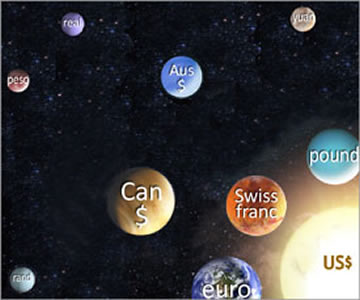 |
Jack: The third reason is the flight to the center. Think of the world currency market as a solar system. The dollar is the sun; the other currencies, the planets. As the system expands, investors migrate from the core currency, the U.S. dollar, to the inner planets — currencies like the euro, the Swiss franc or the pound.
And as the system expands even more, they migrate to the next tier of currencies, like the Australian dollar or the Canadian dollar … and then, still further, to the system's periphery — outer planets like the Brazilian real, the Mexican peso or the South African rand. At each step of the way, they take more risk with less stable economies, use more leverage, go for bigger returns — all fueled by abundant dollar credit.
Martin:
OK. What happens when the global economy contracts?
Jack: Precisely the reverse. As the global economy begins to come unglued, they rush back to the center, creating a massive flight back to the U.S. dollar. They have no love affair with the dollar. They just see the peripheral economies going down and they dump those currencies. These are the first risky investments they sell, almost invariably switching back to U.S. dollars.
The U.S. economy, despite all its troubles, is still the dominant world economy. Militarily, it's the only remaining superpower. Financially, it's still the world's capital. So it's natural that when investors are running from risk, they rush back to the dollar, bidding up its value.
Martin: Is this true across the board, regardless of the currency?
Jack: No. There's one notable exception: The Japanese yen. Japan is the world's second largest economy and also one of the world's largest sources of capital. So when the other currencies go down, a lot of that money goes back to Japan, boosting the yen.
But the main point is this: The single most consistent consequence of global deflation is a rising dollar.
Martin: So in the midst of all these bear markets, if you're looking for a big bull market …
Jack: You've found it! It's the U.S. dollar. I think the U.S. dollar is in the early stages of a powerful bull market that could last for years. It's the single cleanest way to make windfall profits from the deflation.
Martin: A year or two ago, you were betting against the dollar, and you were right. Now you're betting on a rising dollar. That's a big change.
Jack: You're darn right it is! It goes hand-in-hand with the big sea change you've so clearly illustrated today.
Martin: Can you explain to our readers how to go about betting on a rising dollar?
Jack: There are several ways. You can place your bets in favor of the dollar, using instruments that are tied to the dollar index. So as the dollar index rises against other currencies, you profit directly.
Or you can bet against foreign currencies. Remember, the flip side of a rising dollar is falling currencies. The more those currencies fall against the dollar, the more you make. I prefer betting against the currencies because that lets me choose the weakest of them all.
Martin: What instruments do you use?
Jack: I use revolutionary investment vehicles like currency ETFs and World Currency Options.
Martin: Before we get into this any further, can you give us full disclosure on the risks?
Jack: All investments have risk. If the currency goes the wrong way, you lose money. But the advantage of the currency market is that it's divorced from the stock market. The stock market could be crashing, and it would not interfere with your ability to make large steady profits in the currency market. The U.S. economy could be sinking into a depression, and it would still not interfere with your ability to make nice large steady profits in the currency market. No matter what happens in the global economy or the world's financial markets, there is always at least some major currency that's going up in value.
Martin: Please explain that.
Jack: Currencies are measured against each other. When one is going up, the other is going down, like a seesaw. Therefore, there's always at least one currency going up. There's always a bull market in currencies. I don't recommend them for all of your money. But at a time when nearly all other investments are going down, it's a great place to get away from the disasters and find a whole separate world of investment opportunity.
Martin: A world that's far removed from those disasters.
Jack: Exactly. I also think that it's THE ideal vehicle for average investors to profit from deflation and a rising dollar.
Martin: Thank you, Jack. And thank YOU, our readers, for joining us today. Let's talk again soon.
Good luck and God bless!
Martin
This investment news is brought to you by Money and Markets . Money and Markets is a free daily investment newsletter from Martin D. Weiss and Weiss Research analysts offering the latest investing news and financial insights for the stock market, including tips and advice on investing in gold, energy and oil. Dr. Weiss is a leader in the fields of investing, interest rates, financial safety and economic forecasting. To view archives or subscribe, visit http://www.moneyandmarkets.com .
Money and Markets Archive |
© 2005-2022 http://www.MarketOracle.co.uk - The Market Oracle is a FREE Daily Financial Markets Analysis & Forecasting online publication.



